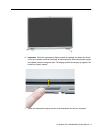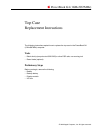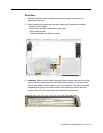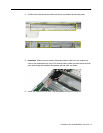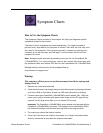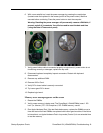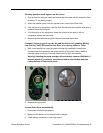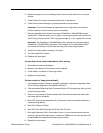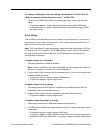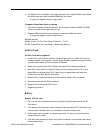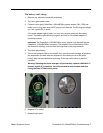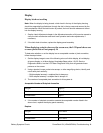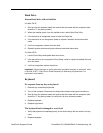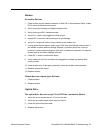
PowerBook G4 (1GHz/867MHz) Troubleshooting - 4
Startup Symptom Charts
4. Make sure system is not over heating, the air vents are clear and unit is not on soft
surface.
5. Check that the fan cable is connected and the fan is operational.
6. Check that the heat exchanger is properly attached to the processor.
Important: If the heat exchanger is separated from the logic board, new thermal
transfer material for the processor must be reinstalled.
7. Remove the battery and connect known-good PowerBook (1GHz/867MHz) power
adapter (661-1798) and power cord or plug to a known-good power outlet; make sure
the DC plug is firmly inserted. The DC plug should light up, if not, replace DC-in board.
Important: The PowerBook (1GHz/867MHz) power adapter must be used with the
PowerBook (1GHz/867MHz) computers. The adapters can be identified by 65W in
the name and markings, and the metal securing-stud on the plug connector.
8. Verify DC-in board cable is securely connected.
9. Try known-good DC-in board.
10. Replace the logic board.
System shuts down almost immediately after startup
1. Disconnect all external peripherals.
2. Make sure the battery is fully inserted and is charged.
3. Check battery connection to main logic board.
4. Replace the logic board.
System crashes or hangs intermittently
1. If the system crashes or hangs in a specific application, replace the application. Mac
OS X: Verify the application is compatible with OS X.
2. Clear parameter RAM. Hold down Command-Option-P-R during startup until you hear
a second startup chime.
3. Perform a clean install of system software with the software install and restore disc
that came with the computer.
4. Mac OS 9: Start up with extensions off to determine if there are system extension or
control panel problems.
5. Mac OS X: Relaunch Finder.
6. Mac OS X: Run Disk Utility. Mac OS 9: Run Disk First Aid.
7. Run Apple Hardware Test in loop mode (Control-L) for an extended time to test the
memory. If the test finds bad memory, replace the DIMMs one at a time and test until
all bad DIMMs are replaced with known-good modules.
8. Replace the logic board.



